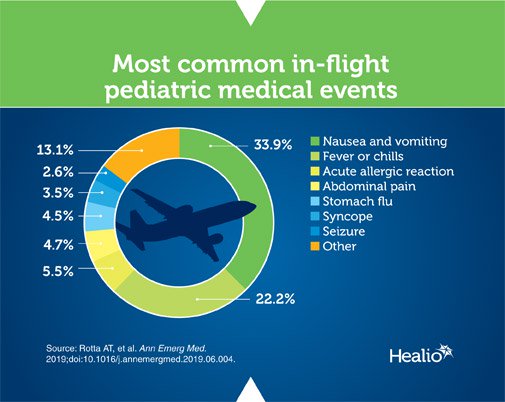83% of pediatric in-flight emergencies resolved onboard

Most pediatric in-flight medical events are resolved during the flight, according to findings from an observational retrospective review published in Annals of Emergency Medicine. Although few of these lead to aircraft diversion, one in six requires additional care after the flight.
“This study is the first to describe the phenomenon of in-flight pediatric medical emergencies from a scientific, epidemiological perspective utilizing a large sample of cases,” Paulo Alves, MD, global medical director at MedAire, told Infectious Diseases in Children. “The research provides us the data to better evaluate the cost/benefit analysis for items to be included in aviation medical kits, ultimately helping regulators, the airlines and, above all, the traveling public.”
According to Alves and colleagues, data on in-flight medical events involving children are lacking. To address this gap, the researchers analyzed records for 75,587 in-flight medical events that occurred between January 2015 through October 2016 and were reported to MedAire, a ground-based medical support center “which provides remote medical support to approximately 35% of the worldwide commercial airline passenger traffic,” according to the study.
Of the calls, 11,719 (15.5%) involved passengers aged younger than 19 years — an age range the researchers defined as “pediatric-aged passengers.” A total of 1,936 (16.5%) pediatric events required additional care at the destination, and 63 (0.5%) resulted in aircraft diversion, the researchers wrote. Most pediatric events (82.9%) were resolved in-flight.

According to the study, the most common medical events involved nausea and vomiting (33.9%), fever or chills (22.2%) or an acute allergic reaction (5.5%). Other common events included abdominal pain (4.7%), gastroenteritis (4.5%), syncope (3.5%) and seizure (2.6%). The researchers reported 11 in-flight deaths. Crew members alone provided 88.6% of in-flight care, with physician passengers assisting in 8.7% of events and nurse passengers in 2.1%.
Alves and colleagues found that the use of onboard medical kits was inversely associated with the need for additional care, but also that standard in-flight kits do not contain pediatric formulations that could provide symptomatic relief of certain conditions.
“Clinicians should be reassured about the overall benign nature of these events, as well as understand their unique role in advising parents traveling with their children on how to pre-plan a trip to avoid complications of known illnesses affecting their patients,” Alves said. “In addition, since health care providers are frequent air travelers but seldom familiar with pediatric emergencies, it should be reassuring to know that most events could be handled by a synergistic cooperation between those on board and the ground-based physicians specialized in this sort of remote medical advice.” – by Joe Gramigna
Disclosures: Alves is employed by MedAire. Please see the study for all other authors’ relevant financial disclosures.
